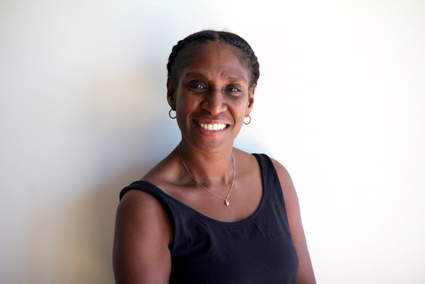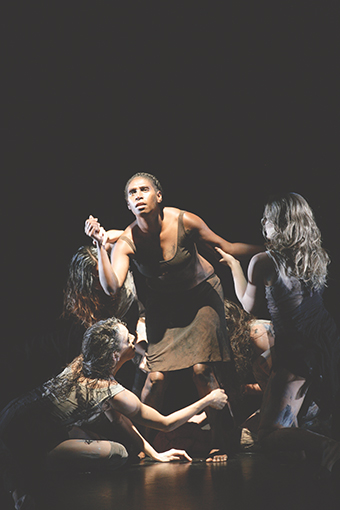Elma Kris: from a Torres Strait Islander perspective
Rianna Tatana: Interview, Elma Kris, Dancer & Choreographer

Elma Kris
photo Tiffany Parker
Elma Kris
ELMA KRIS WAS RAISED ON THURSDAY ISLAND AND IS A DESCENDENT OF THE PEOPLE OF THE WESTERN AND CENTRAL ISLANDS OF THE TORRES STRAIT. SHE IS ONE OF BANGARRA DANCE THEATRE’S LONGEST SERVING PERFORMERS AND CHOREOGRAPHERS. KRIS’ LEADING ROLE IN MATHINNA (2008, 2010) GAINED HER SIGNIFICANT RECOGNITION AS A PERFORMER, MARKING A PIVOTAL SHIFT IN HER CAREER.
The company, under the leadership of Stephen Page, has been responsible for the development of many Indigenous performers and choreographers. Page recognised Elma Kris’ capacity and empowered her to make the transition from performer to choreographer.
When we talked in April 2014, Kris provided a deeper insight into the relationship between culture and dance from a Torres Strait Islander perspective. Her use of language to describe the importance of story and closeness to country in this relationship is simple but evocative and poetic. We discussed her training as a dancer, her second choreographic work for Bangarra, About (2011), and a current project that she is still in the process of developing.
Kris is grateful for her five years of training at the National Aboriginal Islander Skill Development Association Dance College (NAISDA), which provided vital stepping stones to her career with Bangarra. This training provided her with opportunities to “grab onto” cultural knowledge and traditional teachings of dance through cultural tutors who are drawn from specific communities around Australia and who engage the dance students in immersive workshops. Her experience with NAISDA allowed Kris to “nurture myself for my culture.”
Growing up, Kris only ever observed cultural events such as song and dance being performed by her parents or elders of neighbouring islands as she was not called upon to participate. Through the cultural tutors, NAISDA enabled Kris to experience the diversity of the Torres Strait dances and their link with musical patterns and rhythms through the study of both music and dance. “I think coming to NAISDA and seeing similar dances performed… [I was] able to connect with our culture… not only that, it was my first time to actually pick up an instrument and learn how to play it,” she says. Among these instruments were the Warup drum and Kulap rattle, which are both used to accompany dance in the Torres Strait Islands.
Kris is a powerful dancer who is able to evoke strong emotions directly through movement. In About, the first segment of Bangarra’s 2011 production Belong, Kris recreated the visceral experience of the four Torres Strait winds named Zey, Kuki, Naygay and Sager. This was inspired by her parents’ perspective: “This is what mum and dad used to talk about—the winds… their moods, what they do and how we respond and how they paint the sky and land, and how they can make the sea very calm.” She describes how the foam on the beach indicates the violence of the wind and “how the wind will rattle the sea a little bit to make different type of winds.” As a choreographer, coming directly from the rich heritage of Thursday Island, Kris is able to combine her deep cultural knowledge with contemporary artistic expression to create evocative dance theatre in the Bangarra style.
She explains that her choreography is inspired “by something way back home,” which usually emerges from stories passed down to her as a child. “A lot of stories are told that constantly remind us about the spirituality of land, the sea and the sky… and how we’re connected with the environment. They can’t speak but they can show signs and colours, whether it’s aggressive weather or whether it’s good weather.”
In About, there is a profound spiritual resonance in the way Kris is able to recreate the feeling of the Torres Strait winds embodied in the dancers’ movements and supported by David Page’s score. She enacts an extension of traditional cultural transmission by engaging with Indigenous knowledge and customs through the mode of contemporary dance theatre. Kris’ stories invite spectators to engage with and understand the value systems of Indigenous Australian cultures that are presented in ways both evocative and direct. She hopes this gives Indigenous Australians the inspiration to connect back to their culture. At the same time, there is a large emphasis on the importance for non-indigenous Australians “to understand as well… because they’re in darkness without any way of knowing how to connect.” So, Kris’ work reflects Bangarra’s vision to preserve culture through sharing it.

Mathinna, Elma Kris and the Women’s Ensemble, Bangarra Dance Theatre
photo Jeff Busby
Mathinna, Elma Kris and the Women’s Ensemble, Bangarra Dance Theatre
In 2012, Kris was given the opportunity to affirm this vision when she was invited to become a part of the “Engaging Objects: Indigenous Communities, Museum Collections and the representation of Indigenous Histories” project. Consequently she has been involved in extensive research over several years which will culminate in an exhibition in 2015, part of the Encounters project, a collaboration between ANU and the British Museum. Kris will be one of the Australian National University ‘fellows’ who have been asked to engage with key objects from the British Museum’s Australian Indigenous Collection dating back to the 1800s. The resulting contemporary responses and experiences will be a part of the final exhibition. Kris is the sole Torres Strait Islander performing artist working on the project and sees her role as an opportunity to use dance as a vehicle to re-awaken these objects.
At the foundation of the deep spirituality of Elma Kris’ life and creative work is her ability to connect past with present—in Engaging Objects, she tells people about significant objects that have appeared in dreams: “Do you know when you dream and something comes to you in another way and it actually wakens you and it awakens itself to you… and then you ask: What was that? What was I woken by? What was its purpose? Why? So it’s this spiritual thing that comes through your dream and it gives you the ability to waken these other [objects].”
Nonetheless, Kris acknowledges the necessary restrictions of culture, such that only people of a culture are able to access specific knowledge: “there are certain things that we are allowed to awaken or we can’t awaken unless we have gathered protocol[s] to be able to tell it in the deep ways of it… [and] there are things you don’t want to exploit. It’s more about engaging with it and being able to tell a story.” This has prompted Kris to focus on the “awaken[ing] of things that are intrinsic to the woman…” throughout the life of the project. “I wanted to actually engage with a lot of the women’s stuff: to actually express how in our society it’s so important to be able to engage with these objects that have been taken away and how we can preserve them and bring them back… So that way, we are still able to practise things such as weaving baskets because we still need to [continue these] practices.”
Elma Kris has chosen four culturally significant objects that hold intrinsic feminine importance to traditional Torres Strait Islander practice from the British Museum collection. Her contemporary narrative response to these objects will be expressed in a short film featuring Bangarra dancers in an exhibition at the National Museum of Australia in Canberra, November 2015.
For more about Elma Kris visit: http://bangarra.com.au/people/dancers/elma-kris.
RealTime issue #124 Dec-Jan 2014 pg. 32






